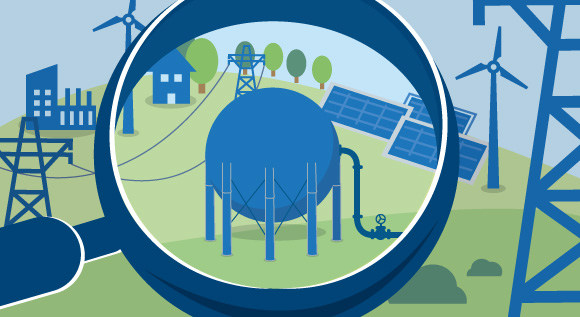What exactly is the Energy Efficiency Roadmap?
This way, please! Rather like a bus timetable, the Energy Efficiency Roadmap sets out the route to an impressive 50% cut in primary energy consumption by 2045. Here’s an overview of the most important “stops” and current changes to the timetable.
 © BMWi
© BMWi
This is what it’s all about: Germany intends to boost its energy efficiency and thus to protect the climate.
We’re always being told that energy efficiency makes sense. But why is this true, and how can Germany become one of the world’s most energy-efficient economies? The formula is a simple one: the cleanest and cheapest energy is energy that we don’t use in the first place. So, in order to make our energy transition a success, we need to become even more efficient in the way we use power and heat. The timetable for more energy efficiency is set out in the Energy Efficiency Roadmap up to 2045. The Roadmap Process is the Federal Government’s science-backed central dialogue forum for driving the necessary progress on energy efficiency, and forms a central plank of the German Energy Efficiency Strategy. The process works as follows: representatives from science, business and civil society are to develop further instruments and measures for increasing energy efficiency in Germany.
The Roadmap was launched on 18 December 2019, when the Federal Government adopted the cross-sectoral Energy Efficiency Strategy 2050. The stated aim at the time: German primary energy consumption was to fall by 30% by 2030 and by 50% by 2050 (from 2008). The target date for the completion of the dialogue process is autumn 2022. The most important “stops” in between are six plenary events, held every six months, of which two took place in 2020 and the third in June 2021.
To ensure that the Roadmap really does cover all the key issues, its principles are being developed in three sector-specific working groups (buildings, industry and transport), and three cross-sectoral working groups (digitalisation, skilled workers and training, and systemic issues). The focus of this work is on medium-term instruments up to 2030 and long-term strategies up to 2045. The third sessions of the working groups took place in spring 2021.
We are now embarking at the most exciting stop so far: this is where the dialogue process really picks up speed. In spring 2021, the Federal Constitutional Court ruled that the Climate Action Act adopted in 2019 places the younger generation at a disadvantage, and called for clear and faster cuts in emissions. It had also become necessary to amend the Climate Action Act as the European Union had raised the climate target for the EU from 40% to 55% by 2030. This means that greenhouse gas emissions should fall by at least 55% compared to 1990.
In mid-May 2021, the cabinet adopted a new version of the Climate Action Act, with more ambitious emission targets along the route: greenhouse gas emissions are now to fall by at least 65% in Germany between 1990 and 2030. The requirement had previously been 55%. Also, Germany is to be climate-neutral by 2045, not 2050. This meant a change to the timetable for the Energy Efficiency Roadmap.
Even more ambitious energy efficiency targets are to be attained by 2045, or five years earlier: by 2030, primary energy consumption is to fall by around 40%, and it must be halved by 2045. An interim report on the roadmap is to be published in June 2021, setting out the measures needed to achieve this. The most important source for this is the findings of the various Roadmap working groups. In addition, there are conclusions drawn from the “Policy instruments for an energy-efficient future” online survey presented on 1 June 2021. Participants in the energy transition platforms on energy transition and buildings had the opportunity here to feed in their views.
A glance at the results achieved so far by the energy efficiency dialogue shows that energy efficiency brings benefits to everyone. First of all, a better energy performance benefits the climate: better energy efficiency means lower carbon emissions. Secondly, it can also save private households, companies and municipalities some real money. Improved energy efficiency will also put German companies in a better position to compete globally. After all, businesses that produce their products using fewer resources and cut their emissions are able to operate at a lower cost and foster innovative technologies and services, which German companies can then sell on the global markets.

